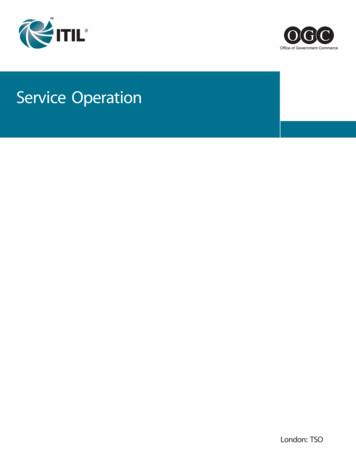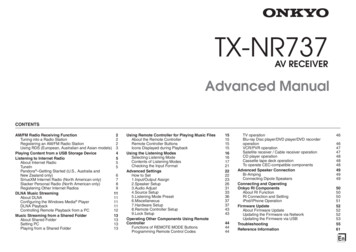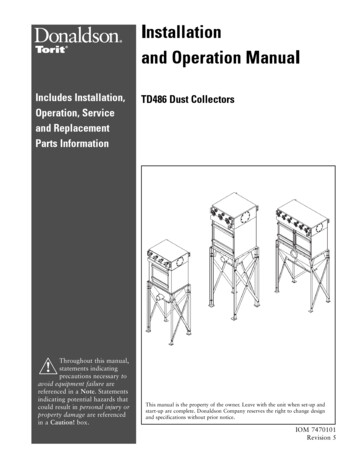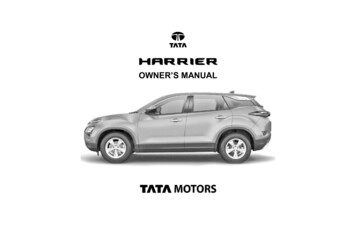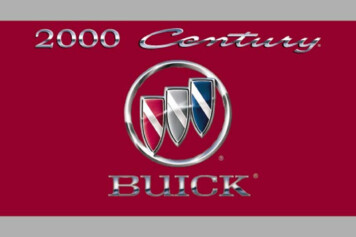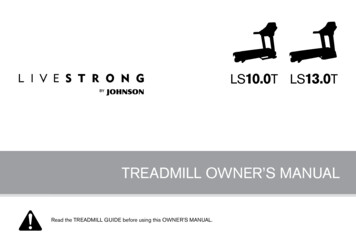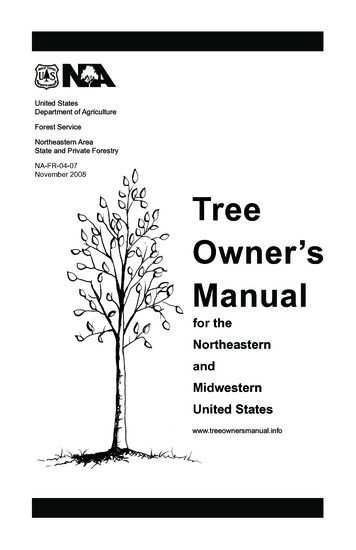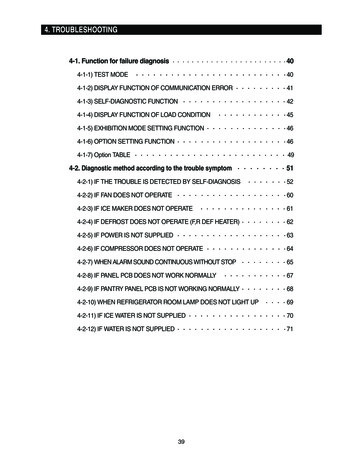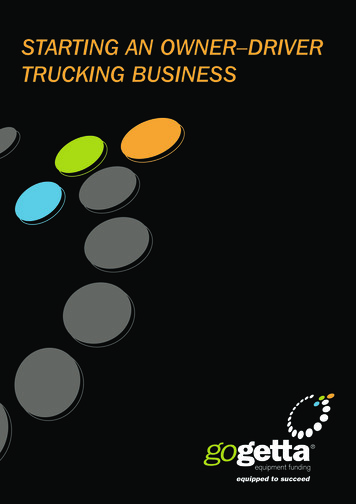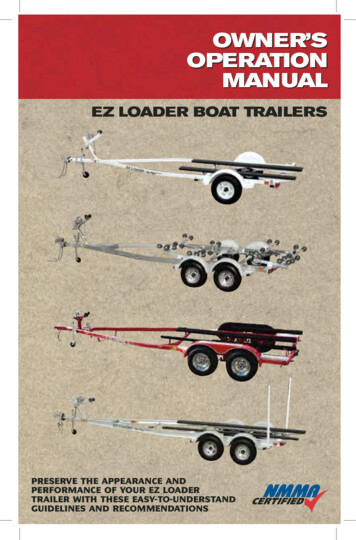
Transcription
OWNER’SOPERATIONMANUALEZ LOADER BOAT TRAILERSPRESERVE THE APPEARANCE ANDPERFORMANCE OF YOUR EZ LOADERTRAILER WITH THESE EASY-TO-UNDERSTANDGUIDELINES AND RECOMMENDATIONS
2page 11Tongue Jackpages 9 - 10Hitch, Coupler & SafetyChain Informationpage 25pages 25 - 27Bearing Lubrication& Wheel SealsWheel, Tire &Hub Carepages 20 - 26Storage andMaintenancepage 13Winch Adjustmentpages 21 - 22BrakesQUICK REFERENCE GUIDEpage 12Lighting System,Wire Color Chartpages 16 - 19Launching andLoading
TABLE OF CONTENTSQUICK REFERENCE GUIDE . . . . . . . . . . . . . . . .2TRAILER MAINTENANCE & STORAGE . . . . . .20Brake Operation & Maintenance . . . . . .21Brake Adjustment . . . . . . . . . . . . . . . . . . .22Tire Changing . . . . . . . . . . . . . . . . . . . . . .24Jack Placement . . . . . . . . . . . . . . . . . . . .24Wheel, Tire, & Hub Care . . . . . . . . . . . . .25Keep Bearings Lubricated Usingthe Greased Bearing System . . . . . . . . .25Keep Bearings Lubricated Usingthe Oil Bath Lubrication System . . . . . . .26Changing or Adjusting Bearings . . . . . . .27Check Wheel Bearing Seals . . . . . . . . . . .27TABLE OF CONTENTS . . . . . . . . . . . . . . . . . . . .3WARNINGS . . . . . . . . . . . . . . . . . . . . . . . . . . . . .4INTRODUCTION . . . . . . . . . . . . . . . . . . . . . . . . .5CHOOSING THE RIGHT TRAILER . . . . . . . . . . . .5Weight Capacity . . . . . . . . . . . . . . . . . . . . .5Trailer Length . . . . . . . . . . . . . . . . . . . . . . . .6Bunk vs. Roller . . . . . . . . . . . . . . . . . . . . . . .6Supporting Your Boat’s Weight . . . . . . . . .6Trailer Braking Systems . . . . . . . . . . . . . . .7TIRE INFORMATION . . . . . . . . . . . . . . . . . . . .28Tire Labeling . . . . . . . . . . . . . . . . . . . . . . .28Location of TIN (Tire Identification Number) . . .28Vehicle Placard & Tire InflationPressure Label . . . . . . . . . . . . . . . . . . . . .28Recommended Tire InflationPressure Chart . . . . . . . . . . . . . . . . . . . . .29Measuring and Adjusting Air Pressureto Achieve Proper Inflation . . . . . . . . . . .30Adverse Safety Consequencesof Under-inflation . . . . . . . . . . . . . . . . . . .30Glossary of Tire Terminology . . . . . . . . . .30Tire Care, Maintenance andSafety Practices . . . . . . . . . . . . . . . . . . . .30Determining Trailer Load Limit . . . . . . . .30Locating Load Limit Information . . . . . . .31Understanding How CargoAffects Trailer Capacity . . . . . . . . . . . . . . .31Adverse Safety Consequences ofOverloading on Handling, Stoppingand on Tires . . . . . . . . . . . . . . . . . . . . . . .31Determining Compatibility of Tireand Trailer Load Capacities . . . . . . . . . . .31ATTACHING YOUR TRAILER . . . . . . . . . . . . . . . .8Hitch Recommendations & Tips . . . . . . . .9Coupler & Hitch Ball Operation . . . . . . .10Using Safety Chains . . . . . . . . . . . . . . . . .10Tongue Jack Use & Care . . . . . . . . . . . . .11Trailer Lights . . . . . . . . . . . . . . . . . . . . . . .12BEFORE YOU TOW . . . . . . . . . . . . . . . . . . . . . .12Tying Down Your Boat . . . . . . . . . . . . . . .12Winch Use & Adjustment . . . . . . . . . . . .13Do not Exceed Load CarryingCapacity or GVWR . . . . . . . . . . . . . . . . . .13Tongue Weight & Weight Distribution . .13Check Tire Pressure . . . . . . . . . . . . . . . . .14Check All Nuts & Bolts . . . . . . . . . . . . . .14Lug Bolt and Nut Tightening Method . .14ON THE ROAD . . . . . . . . . . . . . . . . . . . . . . . . .15Stopping/Following Distance . . . . . . . . . .15Hills . . . . . . . . . . . . . . . . . . . . . . . . . . . . . .15Passing . . . . . . . . . . . . . . . . . . . . . . . . . . . .15Sway/Fishtailing . . . . . . . . . . . . . . . . . . . . .15Road Shoulders . . . . . . . . . . . . . . . . . . . .16Backing . . . . . . . . . . . . . . . . . . . . . . . . . . .16Breakdowns & Accidents . . . . . . . . . . . .16DEFINITIONS . . . . . . . . . . . . . . . . . . . . . . . . . .32WARRANTY . . . . . . . . . . . . . . . . . . . . . . . . . . .33Warranty Registration . . . . . . . . . . . . . . .34Warranty Questions . . . . . . . . . . . . . . . . .34Contact Information . . . . . . . . . . . . . . . . .34GETTING IN & OUT OF THE WATER . . . . . . . .16Roller Trailers . . . . . . . . . . . . . . . . . . . . . . .17Bunk & Custom Trailers . . . . . . . . . . . . . .18Common Causes ofBoat Misalignment . . . . . . . . . . . . . . . . . .19REPORTING SAFETY DEFECTS . . . . . . . . . . . .34REGISTRATION INFORMATION . . . . . . . . . . .35DISTRIBUTOR LOCATIONS . . . . . .Back Cover3
WarningsTHE FOLLOWING SIGNAL WORDS AND SYMBOLS ARE USEDTO ALERT YOU TO POTENTIAL HAZARDS. OBEY ALLMESSAGES AND INSTRUCTIONS THAT FOLLOW THESEWORDS TO AVOID POSSIBLE INJURY OR DEATH.DANGER indicates an imminentlyhazardous situation which, if notavoided, will result in death orserious injury.WARNING indicates a potentiallyhazardous situation which, if notavoided, will result in death orserious injury.CAUTION indicates a potentiallyhazardous situation which, if notavoided, may result in minor ormoderate injury.CAUTION used without the alertsymbol indicates a potentiallyhazardous situation which, if notavoided, may result in propertydamage.4
IntroductionChoosing the Right TrailerWe would like to thank you for purchasingthe best boat trailer made today, anEZ Loader boat trailer. For over 50 years,EZ Loader has been the industry leaderin making quality boat trailers. AllEZ Loader Boat Trailers are NationalMarineManufacturersAssociation[NMMA] and Trailer ManufacturersAssociation [TMA] certified.Weight CapacityDO NOT exceed your vehicle’s GVWRChoosing the right trailer to match yourboat is very important. Your trailer not onlyhas to be long enough and wide enough foryour boat, but must be able to carry theweight of the boat and everything in theboat, including motor(s], fuel, water, personal gear, and other items that you mayhave on board. This final weight is called a‘wet weight’ and cannot exceed the carrying capacity of the trailer. The GVWR [GrossVehicle Weight Rating] listed for the trailer,is the maximum amount that the boat andtrailer combined can weigh. Do not exceedyour trailer’s GVWR. If you don’t know theweight of the boat when its fully loadedcombined with the weight of the trailer,have it weighed.Whether you have purchased anadjustable galvanized, powdercoated, aluminum I-beam or custom-welded EZLoader boat trailer, your new trailer isdesigned to make loading and launchingyour boat easier. Read this manual carefully before you use your trailer because itgives details on the trailer you just purchased. Pay attention to and follow allinstructions and maintenance proceduresin this manual.We have a large dealer network across theUnited States, Canada and the world, making service available to you almost everywhere. Distributors for your area are listedon the back cover of this manual. Pleasecall your distributor to find your nearestdealer. Parts and accessories for your trailer can be purchased through your dealer,directly from the EZ Loader parts department or at EZ loader’s on-line parts storeat www.ezloader.com.The weight of the boat, as listed inthe boat manufacturer’s productbrochure, may not include the weightof the motors, fuel, water and personal gear and should not be usedalone when choosing a trailer.We believe in, and stand behind ourproduct. We know that if you care for yourtrailer, you will enjoy many years ofdependable service from your EZ Loadertrailer. Our sincere thanks from everyoneat EZ Loader Boat Trailers, Inc.EZ Loader Adjustable Boat Trailers SalesCorporation is a proud recipient of the MarineIndustry Certification (MIC) program sponsoredby the National Marine ManufacturersAssociation. NMMA certification is yourassurance of high quality products producedwith strict manufacturing standards and superior service. Always look for the NMMACertification label whenever you are making amarine product purchase.5
float the boat off and on the trailer. Rollertrailers will function well on either shallowor steep ramps and will allow you to launchand load without putting the trailer in thewater as deep as on a bunk style trailer.Some boat manufacturers specify whichsupport system to use with their boats.Please see the “Launching and Loading”section on page 17 for further information.Trailer LengthMake sure when the boat is on thetrailer, there is enough spacebetween the front of your boat andthe back of your tow vehicle.Supporting Your Boat’s WeightWhen choosing a trailer, make sure youtake into account the boats true transomto bow length. Some boats have a bow pulpit, an anchor chock or other hardware onthe bow of the boat, which can extend several feet forward beyond the bow. The trailer tongue must be long enough to give youenough space between your boat and thetowing vehicle, when loading the boat, turning a corner, or backing up so you do nothit your tow vehicle. A less than adequatedistance between the boat and towingvehicle may allow them to contact eachother causing excessive damage to both.Longer or shorter tongues are available asan option on most models. Shorter winchstand posts are also available as an optionon many models and may be necessary forboats with bow pulpits. Measure the lengthfrom the transom to the bow eye to makesure the winch stand can be moved forward or backward, as well as high and low,to meet the bow eye and still have the transom of the boat supported by the rearmost rollers or bunks.Roller and Bunk boat trailers have differentweight distribution characteristics. Forroller trailers, your boat should rest evenlyon the rollers. Once the rollers on your EZLoader boat trailer have been adapted toyour boat, the patented self-adjustingroller system will carry the weight of theboat evenly. The non-marking cushionedrollers protect your boat surface and supply the needed strength and support. Thetongue/keel rollers and the side rollersshould be adjusted where applicable. Thetransom of your boat should rest on therear most roller. If your transom is leftunsupported, severe damage may occur toyour boat. Always use tie-down straps orsimilar approved securing devices tosecure the boat to the trailer, as well as thewinch strap/cable and safety chains/cablessupplied with your trailer. Don’t allow theboat strakes to rest on a roller or bunk.Adjust the roller pattern on the left side ofthe trailer to mirror the roller pattern on theright side. Don’t place rear rollers too farapart. If you do, you could hit the rearcrossmember during launching or loading.If you suspect an adjustment problem,please contact your EZ Loader Dealerimmediately.Bunk vs. RollerThere are 2 basic types of support systemson boat trailers; bunks or rollers. Bunk stylesystems have long support bunks, usuallymade of wood or aluminum, with a carpetor a plastic-like surface. Roller systemsgenerally have multiple sets of rollers tosupport the hull. Bunk trailers operate beston steep ramps where you are able to submerge the trailer deep enough to partiallyBunk trailer users should make sure thatthe long, straight bunks evenly carry theboat’s weight. If one side of your boat ishigher than the other side, adjust the bunksto the same height. The transom of yourboat should be even with the back end ofthe bunk. If your transom is left unsupported,6
Hydraulic Surge [Disc Brakes]severe damage may occur to your boat.If bow and center supports are used, makesure that no large amount of pressure isplaced on the hull in any one spot, whereflexing could occur. As with roller trailers,the bunks and hardware on the left side ofyour trailer should be the same as on theright side.Hydraulic surge disc brakes operate on thesame idea as hydraulic surge drum brakes.The disc brake needs a special actuatorwith a back-up solenoid wired into the towvehicle’s reverse lights. When the tow vehicle is put in reverse, the solenoid locks outthe braking system allowing the trailer toback up on level ground without the brakeslocking up.Always keep tie–downs tightly fastened.Always use tie-downs or similar securingdevices to secure the boat to the trailer, aswell as the winch strap/cable and safetychains/cables supplied with your trailer.Since you can see most of the disc brakecomponents, they are easy to keep cleanand maintain.Electric [Drum Brakes]Electric trailer brakes are not hydraulic andare not independent of the tow vehicle.Since this system does not have hydraulicparts, it is easier to install on the trailer.With electric brakes, the driver can adjustthe amount of braking on the trailer andcan apply the trailer brakes alone by usingthe brake controller mounted in the towvehicle. The brake controller is an additional part and must be put in the tow vehiclefor electric trailer brakes to work. The brakecontroller senses when the tow vehicle isslowing down and puts on the trailerbrakes. This type of braking system alsoworks when backing up the trailer. In addition to the brake controller in the tow vehicle, electric brakes must have a battery onthe trailer in case the trailer is disconnected from the tow vehicle while it is moving.Some state laws require brakes ontrailers with a GVWR of 1,500pounds or more.Trailer Braking SystemsEZ Loader Boat Trailers offers three different state-of-the-art braking systems;Hydraulic surge [drum brakes], hydraulicsurge [disc brakes], and electric [drumbrakes]. All three braking systems offerexcellent trailer braking, but each haveunique qualities.Hydraulic Surge [Drum Brakes]Hydraulic surge drum brakes have beenthe boat trailer standard for decades.These trailer brakes are dependable andquick to react, are independent of the towvehicle, and come on automatically whenyou press the brake pedal in the tow vehicle. As the tow vehicle slows down, the trailer wants to keep moving forward. Thismoves the brake actuator and applies thetrailer brakes. This ‘surge’ action is wherethe surge brakes get their name.Electric brakes must have a brakecontroller in the tow vehicle andanother charged batteryon the trailer.7
Attaching Your TrailerAlways get help to back your towvehicle to your trailer. NEVER movethe trailer to the tow vehicle.Before hitching your trailer to your towvehicle, please check the items listed onthe decal located on or near the winchstand. [See Figure 1 on the right]Your EZ Loader Dealer will provide another decal if it is missing or illegible.Make sure the coupler lever is up [coupleris open]. Raise the front of the trailer withthe tongue jack. Back your tow vehicleclose to the trailer, then get out and checkthe location of the coupler and hitch ball.Move your tow vehicle until the coupler isover the hitch ball. Using the tongue jack,lower the trailer until the coupler completely covers the hitch ball. Lock the coupler [coupler lever is down].Make sure the coupler completelycovers the ball and thatthe ball clamp inside the coupleris below the ball,not on top of the ball.Use a padlock or 1/4 inch bolt andnut to secure the coupler lever inthe locked [down] position.After the coupler is locked on the hitch ball,raise the front of the trailer using the tonguejack. If the coupler comes loose, open the coupler [lever up], attach the coupler to the hitchball and raise the front of the trailer again. Ifthe coupler will not stay attached, check thehitch ball and coupler for size and damage.Fig 1: Trailer Warning Decal8
After the coupler is secured to the hitchball, raise the tongue jack all the way. If youhave a swing-up style tongue jack, turn it tothe traveling position and make sure thelock pin is secure in the hole. If your trailerdoes not have a tongue jack, you can buyone at your EZ Loader Dealer or atEZ Loader’s on-line parts store at[www.ezloader.com].Two types of trailer hitches are normallyused: Weight carrying hitches which attachto the tow vehicle and support the trailertongue weight only, and weight distributinghitches which transfer some of the tongueweight to the tow vehicle by using extraspring bars on each side of the trailer ball.Bumper hitches are not recommended forboat trailers.For most boat trailers, a weight-carryinghitch is usually adequate. Weight-distributing hitches are recommended for veryheavy loads. Before you decide whichhitch to buy, contact your EZ LoaderDealer and read the manufacturer’srecommendations for your towing vehicle.EZ Loader does not recommend selfinstallation of trailer hitches.Make sure the jack is in the storedor traveling position before towingthe trailer. If it is not, it can causethe trailer to separate fromthe tow vehicle.If you choose a weight-distributing hitch,contact a dealer specializing in hitches andhitch installation to make sure it is properly installed, that it is compatible with yourtrailer’s brake system and that you don’texceed weight requirements.Cross the safety chains or cables under thetongue and attach them to the tow vehicle.Connect the trailer wiring harness to thelighting system of your tow vehicle.Remember to check your lights. If electricbrakes are used, make sure to connectthe brake wiring to your tow vehicle’sbrake wiring.Spot check all other trailer components[i.e. tires and tie–downs].Do not use weight-distributinghitches with surge-braked trailers.Overloading or improper installationof weight-distributing hitches maynot let hydraulic surge brake actuators work and the tow vehicle andtrailer may take longer to stop.You should be all set to go.Hitch Recommendations and TipsSeveral models of weight distribution hitches will render the brakes inoperative. EZLoader cannot assume responsibility oraccept warranty claims in such instances.Please make sure the weight distributionhitch you choose is compatible with thetrailer’s braking system. EZ Loader nowoffers a state-of-the-art electric cab-controlled braking system that will not beimpaired with the use of weight distributingYour trailer’s GVWR must not exceedthe capacity of your hitch. Be sureyou have the right size ball, shank,and capacity to match your trailer’smodel and coupler size. Thecorrect ball size and capacity ismarked on the coupler.9
Loosen or tighten the nut on the bottom ofyour coupler so the latch closes firmly witha tight fit on the ball. Class IV Couplers andhydraulic brake actuators usually need noadjustments. Keep the latch mechanismclean and lightly oiled.hitches. Please go to www.ezloader.comfor additional information.If the latch mechanism or coupler is bent ordeformed in any manner, do not use thetrailer until a new latch assembly or coupleris installed. Replacement assemblies andrebuild kits are available at your EZ Loaderdealer or at EZ Loader’s on-line store atwww.ezloader.com.For proper load distribution on tandem and triple torsion axle trailers,it is very important that the trailer isparallel to the ground while towing.Please Note: Hitch ball height is determined by measuring from the ground tothe top of the coupler ball housing whenthe trailer is on a level surface. The averageheight to the top of the hitch ball is usuallyfrom 14 inches to 21 inches above theground when loaded. Actual height willvary from trailer to trailer.Coupler and Hitch Ball OperationFig. 2: Coupler on ball with latch inproper lock position.Do not use a different size ball,shank, or capacity than recommended and be sure both the hitch balland hitch ratings are the same ormore than the Gross Vehicle WeightRating of your trailer.Using Safety ChainsEvery coupler on an EZ Loader boat traileris permanently marked with;Always attach the trailer and boatbow safety chains before towing.a] Manufacturer’s code, name ortrademark;Your trailer hitch should have a place toattach the trailer safety chains or cables.Crisscross the trailer safety chains or cablesunder the trailer tongue before attaching tothe towing vehicle. [See Figure 3] Most statelaws require the crisscrossing of these chainsor cables. This may prevent the trailer tongueb] SAE coupling designation and grosscoupler rating;c] Part number or style model; andd] Proper ball diameter.10
from falling to the road in the event that thetrailer coupler becomes detached from thehitch ball. Do not connect the trailer safetychains or cables together.Original trailer safety chains or cables shouldnot be removed or tampered with. Shouldyou need to replace them, contact EZLoader or your EZ Loader Dealer forreplacement chains or cables and hooks.Back your tow vehicle to your trailer.DO NOT move your trailer to thetow vehicle. When the trailer ismoved without a tow vehicle,the brakes do not work.Note: Some States/Provinces require closedconnections on trailer safety chains orcables. Check with your State/Province forspecific regulations regarding closed connections on trailer safety chains or cables.If your jack is a swing up type, return it to itsstowed [up] position, making sure the securing pin is firmly in it’s hole. [See Figure 4] Ifyour jack is not a swing-up type, retractyour trailer jack completely [wheel raised ashigh as possible] before towing the trailer.Care must be used when engagingor disengaging a swing-up styletongue jack.When using the jack in the down positionto support weight, make sure the securingpin is firmly in it’s hole before adding anyweight to the jack. If the securing pin is notfirmly in it’s hole, the jack may collapseunder the weight placed on it. While towing, if your jack is not folded up or retracted completely, damage could result andyour jack may have to be replaced.Fig 3: Proper attachment of the safetychains is essential to trailer safety. Notehow the safety chains are crisscrossed.Like the winch, or any kind of mechanicalassembly, a jack requires lubrication maintenance. Regularly grease the drive gear,and rack & pinion – and oil the caster andwheel bearings.Tongue Jack Use and CarePlace the jack into position, crank the jackhandle until the trailer coupler is highenough for the coupler to go over the hitchball and lower the trailer coupler onto theball by cranking the jack handle in theopposite direction.Fig 4: Swing jack in traveling position.11
Trailer LightsWire Color CodeYellow and Brown . . . . . . . . . . . . .LeftGreen and Brown . . . . . . . . . . . .RightBrown . . .Tail lights, rear marker light,front and rear side lightsYellow . . . . . . . . . . .Left stop and turnGreen . . . . . . . . . .Right stop and turnWhite . . . . . . . . . . . . . . . . . . . .GroundBlue* . . . . . . . . . . .Underwater lightsAlways check your trailer lights tomake sure they are in working orderbefore any trip.If your trailer has electric brakes,unplugging the trailer wire fromthe tow vehicle will disable thetrailer brakes.* Custom trailers onlyFig 5: EZ Loader Wire Color CodeBefore You TowYour EZ Loader boat trailer is equippedwith the best lighting system available.Always double-check your lights to makesure they are in working order beforeany trip.Tying Down Your BoatTwice a year, it is a good idea to trace thewiring system from the tow vehicle to yourboat trailer’s taillights and look for barewires, cracked insulation or corroded terminals. Always be sure the white groundwire is connected to the trailer frame.Replace all worn or damaged parts.Always attach the boat bow safetychains. Make sure the boat is secureand held in place before towing.Tie down the boat securely at the stern, inboth a downward and forward direction,with approved tie downs. Use the rear tiedown points provided on your trailer.Waterproof grease, petroleum jelly, or WD40 should be put on plug contacts andbulb bases to prevent rust and corrosion.A boat bow safety chain is provided onmost EZ Loader models and should beattached to the bow eye of your boat afterthe winch firmly pulls the boat against thebow stop. Do not depend on the winchline, strap or cable alone to hold yourboat secure.Tow vehicles with three-light lighting system[different lights for brake, turn, and taillights] need an adapter to change thethree-light system to a two-light system.Make sure your vehicle is equipped withthe proper lighting package. We recommend that a professional, i.e. your automotive dealer, install it for you. EZ Loader’sWire Color Code is listed to the top right atFigure 5.Check the winch line, strap or cable for fraying, cuts or tears. If it is damaged, replaceit immediately.If the winch line and tie–downs are tightand you are still able to rock the boat onthe trailer, check the settings of the bunksand/or rollers and winch adjustment.Even though your lights are submersible,it is still advisable to always disconnectthe light harness prior to submergingthe trailer.12
Winch Adjustment and UseMaintenance of the mechanical winch is simple. Keep clean, lubricate regularly and applyheavy grease to the gears frequently. Makesure the winch line, strap or cable doesn’t rubagainst anything sharp; fraying and wear couldresult. If your line, strap or cable becomesworn, contact your EZ Loader Dealer forreplacement as soon as possible or visitEZ Loader’s on line store at www.ezloader.comNever disengage the winch ratchetlock while winching your boatonto the trailer.Whether your winch is a hand-operatedmodel [standard] or an electric model[aftermarket], both can be adjusted for thebest possible performance. The winchheight should be adjusted so that thewinch cable/strap is level with the bow eyeof the boat when the boat is resting on thetrailer, with the bow stop roll or vee blockjust above the bow eye of the boat. Yourboat will then be pulled in a straight lineonto the trailer and against the bow stopon the winch stand. The angle the winch ispulling your boat should not make the boatlift up or pull down when pulling the boweye against the underside of the bow rolleror vee block. It should pull the bow eyestraight into the underside of the bow rolleror vee block. [See Figure 6]Do not Exceed Load CarryingCapacity or GVWRMake sure the total weight of thetrailer, boat, engine, fuel, batteries,and gear does not exceed thetrailer’s GVWR.The weight capacity of your trailer is foundusing the Gross Vehicle Weight Rating[GVWR] of the trailer. The GVWR is printedon the Vehicle Identification Number [VIN]decal at the left front of the trailer. If you donot know the weight of your trailer withboat, motor[s], fuel, gear, etc., have itweighed. [See SCALES in the yellow pages.]The trailer must not be connected to thetow vehicle when you get the total weightof the trailer. It is up to you to make surethe weight of your boat, trailer, and boatcargo does not exceed the GVWR.Bow eye must besnug under thebow stop rollerBow safety chain(lock chain inkey hole slot onlarger models)Tongue Weight &Weight DistributionWinch lineshould beparallel withthe tongueof the trailer(avoid pullingdown)Poor weight distribution can causetrailer sway [“fishtailing”] and putextra force on your boat, trailer,towing equipment, and tow vehicle.Fig 6: Proper winch operation13
Proper load distribution on your trailer is alsovery important. Five to ten percent of yourtrailer’s Gross Vehicle Weight should be supported by the hitch ball, with the tonguelevel. This is called “tongue weight”. For example, if the GVW of the boat, gear and trailer is1,500 lbs., the weight on the coupler shouldnot be more than 150 lbs. – or the maximum rating of the hitch [whichever is less] –or be less than 75 lbs. For lighter boats, asmall scale [like a bathroom scale] can beused to check the weight on the coupler.Tire E480X12B480X8B530X12B530X12CST175/80R13BST175/80(R or D)13CST185/80(R or D)13CST205/75R14BST205/75(R or D)14CST215/75(R or D)14CST225/75R15DST235/80R16DIf you are over or under the standard weightdistribution, try moving gear inside your boatfirst. If further adjustment to the trailer is necessary, contact your EZ Loader s3000lbsFig 7: Tire pressure chartCheck All Nuts and BoltsYour trailer’s GVWR must notexceed the capacity of your hitch.Even though EZ Loader uses self–locking,vibration resistant nuts, it is the owner’sresponsibility to make sure all of the fastenersare tight before using the trailer – not just thefirst time you use it, but on a regular basis.Check with your EZ Loader Dealer orautomotive dealer to make sure youhave the proper towing vehicle for theload you’ll be pulling. Check your vehicle manufacturer’s hitch weight recommendations as well. Be sure you havethe right size ball, shank and capacityto match your trailer’s model and coupler size. The correct ball size andcapacity is marked on the coupler.Lug Bolt or Nut Tightening MethodCheck your lug bolts or nuts fortightness before every trip.If you lose a lug bolt, replace it promptly with thecorrect size. Use 60 degree cone angle zincplated lug bolts.Check Tire PressureInitially tighten to 12-20 foot pounds, using a tightening sequence on a 5 bolt wheel of 1,3,5,2,4or on a 6 bolt wheel 1,4,6,3,2,5 – see Figure 8.Keep your tires inflated to therecommended tire pressure on theVIN decal [found on the leftfront of your trailer]. Check thetire pressure before each trip.Finish torquing to 90-95 ft. lbs. or lug nuts to85 foot pounds. Re-torque after 50 miles ofuse and on a periodic schedule from then on.Lug bolts or nuts should be clean and dry.Do not put grease or other lubricant on them.14
Hills15To prevent your tow vehicle’s engine fromlugging when going up hills, shift into lowergears. This will improve gas mileage andreduce engine overheating.2164Swaying or “fishtailing” happens moreoften going downhill. To prevent this fromhappening, decrease speed BEFORE goingdown the hill. If your trailer has surgebrakes, do not shift into lower gears whengoing downhill. This can make the trailerbrakes come on the whole time you aregoing downhill and may cause your trailerbrakes not to work.35 bolt hub25436 bolt hubFig 8 Lug bolt orderDO NOT ride the brake pedal going dow
QUICK REFERENCE GUIDE QUICK REFERENCE GUIDE 2 Hitch, Coupler & Safety Chain Information pages 9 - 10 Winch Adjustment page 13 Launching and Loading pages 16 - 19 Storage and Maintenance pages 20 - 26 Bearing Lubrication & Wheel Seals pages 25 - 27 Wheel, Tire & Hub Care page 25 Tongue Jack page 11 Lighting System, Wire Color Chart page 12 Brakes pages 21 - 22

